greentraveller

Island hopping
Take the ferry between the Ionian Islands
Travel like a local
See community-based conservation in action in Saint Lucia


Island hopping
Take the ferry between the Ionian Islands
Travel like a local
See community-based conservation in action in Saint Lucia

READ MORE


Gran Canaria’s diverse landscapes and distinct microclimate allow for excellent grape-growing. Journey along this wine trail to find the region’s best vineyards, bodegas and restaurants, as well as outstanding views.

©GREENTRAVELLER 2025.
Greentraveller Limited, Glove Factory Studios, 1 Brook Lane, Holt, Bradford on Avon BA14 6RL Wiltshire, Unted Kingdom
T: +44 (0)7557 025542
E: info@greentraveller.co.uk
W: greentraveller.co.uk
While every effort is made to ensure accuracy, Greentraveller Limited cannot be held responsible for any errors or omissions.
FRONT COVER: Richard Hammond
ICONS: flaticon.com
Graphics: freepik.com
MAPS: freevectormaps.com
MAGAZINE EDITOR: Richard Hammond richard@greentraveller.com
MAGAZINE DESIGNER: Claire Gates clairegatesdesign@gmail.com
Where you see these symbols throughout the magazine you can be assured that the destinations featured can be reached without flying or that the activities featured aim to have a positive impact for the community, environment or wildlife in the region.
Welcome to the autumn issue of our Green Traveller magazine –the magazine of the website greentraveller.co.uk
You’ll hopefully find lots of inspiration in this issue, from hiking the glorious Golden Valley Pilgrim Way in Herefordshire (p22) and island-hopping across the Ionian Islands (26) to exploring the rural side of life in Gran Canaria (p16) and seeing community-based conservation travel in action on the beautiful Caribbean island of Saint Lucia (p32).
Tap in ‘green hotels’ into a search engine and you’ll be presented with a bewildering range of options, some more eco-friendly than others. It can be hard to know the green from the green wash. So in our ‘Best of British’ feature, I’m delighted to pick out three places are going the extra mile to reduce the impact of your stay on the environment.
As always, keep an eye out for the flight-free and positive impact icons throughout the magazine that distinguish between those trips that can be reached overland with those that bring genuine benefits to destinations through nature conservation, local community empowerment and humanitarian aid.
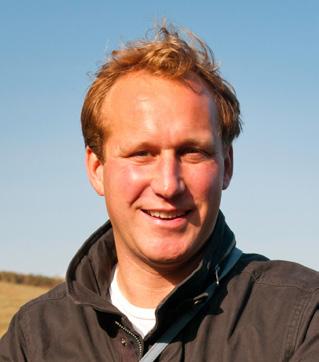
Happy green travelling!
Editor, Green Traveller Magazine



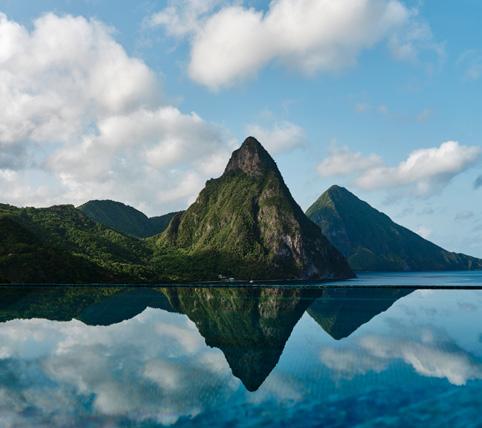

Soweto (SOuth WEstern TOwnship) in South Africa was originally built to house workers employed in the nearby diamond and gold mines. There’s a sobering history here and you can uncover it via a tour (either by tuktuk or bike) with Lebo’s backpackers right in the heart of the community. While it’s tempting to capture people and street scenes on camera, it’s important to make a connection with the people you meet first, and gain permission before taking any photos.

Words &
pictures
by Diana Jarvis (dianajarvis.co.uk)

We were specifically asked not to take any photos while touring the back alleys of the township where we were greeted warmly by everyone we met. It’s ironic, without the focus on taking photos, I somehow remember those interactions more vividly than if I’d committed them to camera.

At an unassuming shack and were treated to atcha, beef cheeks and polenta. After chatting with the chefs, Nathaniel and Kokayefo, they were only too happy to pose for photos while they prepared their meat.

At the hill-top community garden, Thespto tells us how using permaculture principles and seasonal growing helps navigate the water shortages without compromising the array of produce –such as carrots, beetroot, spinach, rosemary, squash and more –grown here.

Leeds council has been named Green Council of the Year in the Nature 2030 campaign. In presenting the award, Allison Ogden-Newton OBE, Chief Executive of the awards sponsor Keep Britain Tidy, highlighted the council’s progress in electrifying its vehicle fleet, the carbon benefits of the innovative Leeds PIPES energy from waste district heating scheme, and praised the reduction in the amount of household waste that ends up in landfill, from 26 per cent ten years ago to less than 0.2 per cent today.
Tailor-made holiday secialist, Fred Holidays has published a train travel guide to help its customers understand where they can travel by train in day in the UK and across to Europe as part of a drive to promote its rail holidays, which include budget rail breaks, grand rail tours, and luxury rail holidays throughout the continent.
Sally Barlow, Rail Product Manager, Fred.Holidays, says: “Our product managers have many years of experience and we have created a range of carefully-curated rail holidays designed to suit all tastes. With legs stretched out, enjoy an on-board snack and a tipple, or just watch the world go by - travelling by train really is the way to get to the heart of any destination with the least amount of hassle, lower carbon footprint and most importantly, avoiding those airport and baggage reclaim queues!” www.fredholidays.co.uk/rail-journeys

A new multi-day walking route has launched in the North Pennines National Landscape and UNESCO Global Geopark. The ‘Roof of England’ Walk is a journey around the North Pennines, with its name reflecting its lofty location in the uplands of Northern England where walkers can tackle some of the country’s highest footpaths and enjoying views of open moorlands, big skies, and horizons.
The route makes its way through County Durham, Cumbria and Northumberland, the three counties of the North Pennines National Landscape, as well as a section in the Yorkshire Dales National Park to enable a visit to Nine Standards Rigg.
The route takes in the spectacular
waterfalls of Teesdale in County Durham: Low Force, High Force and Cauldron Snout. In Northumberland there’s the dramatic river gorge at Allen Banks, the lead mining site at Dukesfield Arches and the history of Blanchland Abbey. The Cumbrian sections take in the jaw-dropping High Cup Nick and High Cup Gill and reach the highest point of the North Pennines at Cross Fell.
The wall takes walkers alongside rare and important habitats such as blanket bog, hay meadows, ancient woodland and upland rivers and streams. The area is a haven for bird and wildlife watchers year-round, with a highlight being the great numbers of wading bird species on the high moors in spring and summer.

Walkers can do the 14-day route in one continuous journey or complete it in four short breaks of three to four days each. The individual legs of the long-distance trail also make great one-day or part-day linear walks across some wonderful scenery.
As it is circular, walkers can choose one of many convenient starting points, including Haltwhistle, Middleton-in-Teesdale, Wolsingham, Stanhope, Alston, Allendale and Kirkby Stephen. It is accessible by train at Appleby, Kirkby Stephen, and Haltwhistle, and by local bus services.
Chris Woodley-Stewart, Director of the North Pennines National Landscape, said: “We are very pleased to have reached the milestone of making this route available and to be able to share a new way to explore the North Pennines National Landscape and UNESCO Global Geopark.
“Since the very first Roof of England walking festivals in the 1990s, we have encouraged walkers to explore the high uplands of the North Pennines. The name captures the sense of elevation and space offered by a walk through this very special landscape.”
The development of the Roof of England route has been co-ordinated by the North Pennines National Landscape’s Responsible Tourism Lead, Shane Harris, who said: “It has been a privilege to be part of the team that has realised the ambition of Cllr Bob Pendlebury – the first Chair of what was then known as the North Pennines Area of Outstanding Natural Beauty Partnership. Bob was a leading light in Crook Ramblers, a keen walker, and he was enthusiastic about developing a circular walk around the North Pennines, a landscape he loved.
“I’m sure Cllr Pendlebury would have been delighted that people can now start to enjoy the Roof of England Walk and take their own North Pennines journey.”
www.RoofofEnglandWalk.org.uk
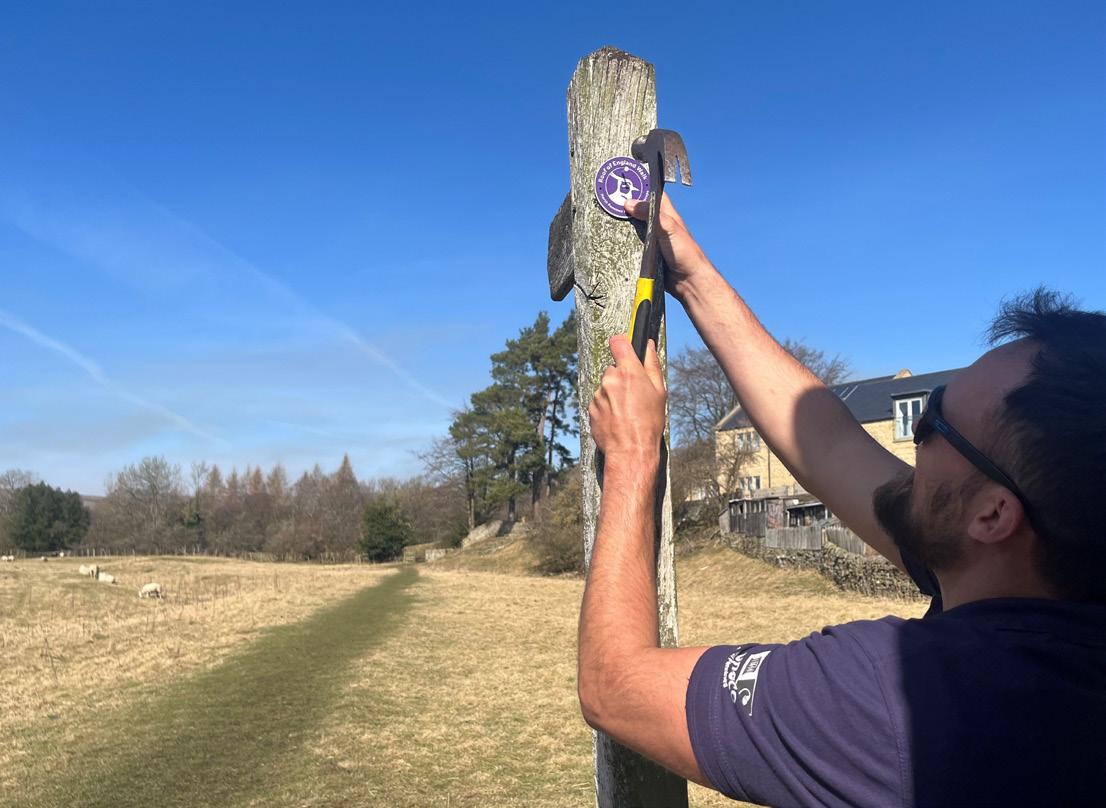
Native – the sustainable landscape hotel at Ballydehob on the southwest coast of Ireland – is introducing three new garden suites this autumn that “combine Irish vernacular with contemporary design”. 20% of Native’s profits fund the planting of native plants and trees at its nearby 75-acre rewilding site. If you can stir from the idyll, go wild swimming in the waters of Barleycove beach, night kayaking to spot the bioluminescence in Loch Hyne, visit Skibbereen’s artisan farmer’s market, and have a pint in the spectacular garden of Ahakista’s Tin Pub on the wild and rugged Sheep’s Head Peninsula. www.native.ie

Small-group adventure tour operator, Exodus Adventure Travels, has launched a major fundraising campaign to support its conservation mission of ‘supporting communities to protect key species globally’.
Following the introduction of two new projects – saving endangered primates in Vietnam and supporting jaguar conservation in Costa Rica – ‘Wild at Heart’ has proudly been launched by the Exodus Adventure Travels Foundation. The fundraiser will support initiatives across all of Exodus’ key destinations, including existing
projects aimed at maintaining tiger habitats in India, protecting elephants in Kenya and educating communities on bear preservation in Italy.
Kasia Morgan, Head of Sustainability, Exodus Adventure Travels said: “Connecting adventurous travellers with incredible destinations is what we do, always with a view on how our adventures can benefit local species, environments and communities. Our ‘Wild at Heart’ campaign is the next chapter in this commitment to support thriving nature and thriving people. We are excited to invite Exodus customers to join us in
supporting this campaign, and helping protect the places they explore, and the species that make these destinations memorable.”
“We’ve made it as easy as possible for people to contribute to the project of their choice, and 100% of donations will go towards the work on the ground. As little as £5 could fund a set of camera batteries to monitor the reintroduction of a jaguar prey species in Costa Rica, while £12 is enough to equip a local Rewilding Ranger in Vietnam with essential patrol gear.” www.exodus.co.uk/foundation/wild-at-heart

An electric hydrofoil ferry has been trialled in the waters off Gothenburg, West Sweden. Reaching speeds of up to 25 knots and with a range of 40 nautical miles, Candela’s P-12 shuttle could be the commuter ferry of the future. www.candela.com

The governments of Guatemala, Mexico and Belize have signed an agreement to create a ‘Biocultural Corridor of the Great Mayan Forest’, linking 27 protected areas in Guatemala, 11 in Belize and 12 in Mexico, including renowned sites such as Mirador-Río Azul National Park, Aguas Turbias Protected Natural Area and Calakmul Biosphere Reserve.
The reserve will cover 5.7 million hectares of mixed ecosystems, lowland, mid and highland tropical rainforests, and Petenes mangroves, home to around 7,000 species, including 200 at-risk and 50 priority species. Iconic wildlife includes jaguars, tapirs, spider monkeys and quetzals.
Beyond biodiversity, the corridor honours the living cultures of indigenous Mayan and Afro-descendant communities, who are recognised as guardians of the forest. The three nations will share expertise and resources to manage threats like illegal logging, deforestation and wildfires, while promoting sustainable use of forest resources for local communities.
The Maya Forest is also home to archaeological treasures such as Naranjo in Guatemala, Calakmul and Balamkú in Mexico, Yaxhá, Nakum, and La Milpa in Belize. More information about Guatemala: www.visitguatemala.gt
Heilbronn named European Green Capital 2027
The German city of Heilbronn has been named as European Green Capital 2027. According to a statement from the European Commission, the award was given to Heilbronn because of its “successful intersectoral collaboration of noise, climate and air pollution into its ‘Landscape Plan 2030’ and the city’s ‘Mobility Concept’. Citizen engagement is central, with participatory platforms, awareness campaigns, and protection for quiet areas”. The jury also recognised the city’s ambitious targets for 2035. The city will be granted a financial prize of €600,000. Heilbronn succeeds 2026 titleholder Guimarães, Portugal and 2025 titleholder Vilnius, Lithuania.

Tap in ‘green hotels’ into a search engine and you’ll be presented with a bewildering range of options, some more eco-friendly than others. It can be hard to know the green from the green wash. Here are three places Green Traveller’s Richard Hammond picks out where the owners are going the extra mile to reduce the impact of your stay on the environment.
A family-owned and run ‘bistro with beds’ (plus five cottages & two glamping pods) on a 17th century converted sheep farm on a hillside location in Grasmere in the Lake District. The entire site is powered by a combination of an on-site eco-friendly 100kw biomass boiler, an air-source heat pump, and hydroelectricity. from the nearby hydro The on-site bistro serves up food sourced from the local area and you can choose to order dishes from their ‘Mindful Menu’ – the carbon emissions of each dish is provided on the menu, with detailed information on the origin of ingredients, sustainable practices, and the resulting environmental impact of their menu choices. www.theyan.co.uk
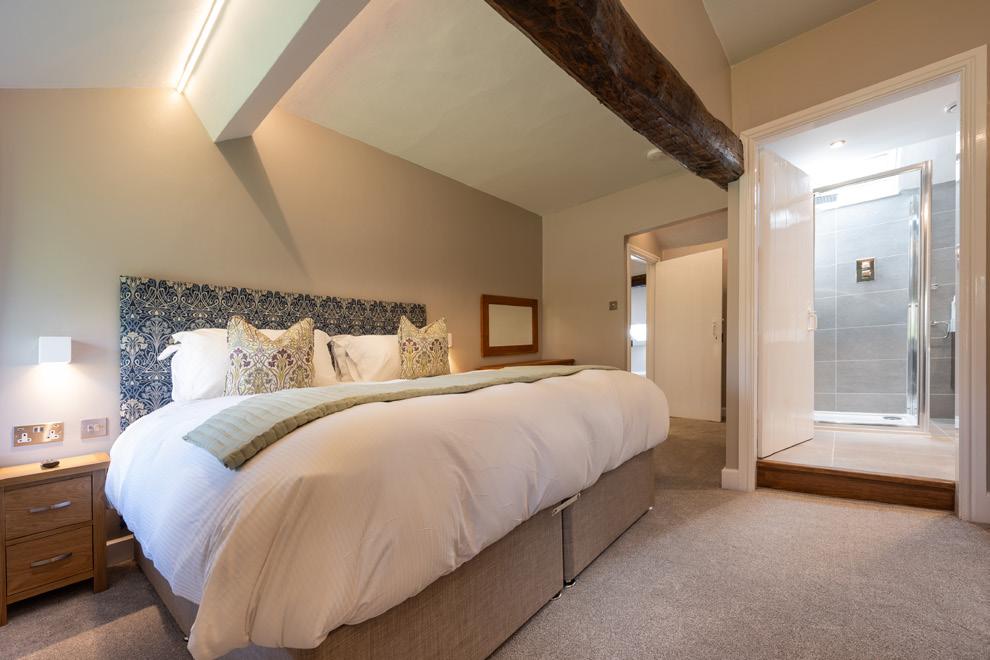


A splendid listed Georgian house on a onethousand acre working farm and woodland just outside Ludlow. Owners Arabella and Hugo Salway are a fifth-generation farming family who’ve opened up their home - and the land around it - to guests “looking for something slower and authentically ‘Shropshire.’” Trails lead directly from the front door into Mortimer Forest and beyond, so there’s no need for a car - Ludlow is walkable or reachable by transfer from the station. Heats comes from a biomass boiler fuelled by locally sourced wood chip, there are solar panels for electricity, a private water supply, and a spring-fed Georgian plunge pool www.thesalweylodge.co.uk
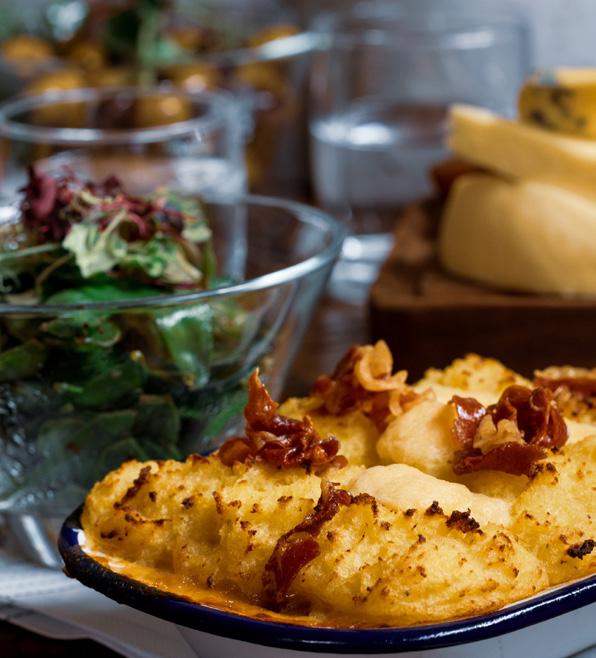

Five beautiful self-catering holiday cottages converted from 18th Century farm buildings, ten miles from Ledbury, Herefordshire. Each have one or two bedrooms, sleeping up to five people. There’s a fast-charging point for electric cars and a range of bikes and e-bikes for daily hire. The Malvern Hills are on the doorstep, great for gentle walks or you could walk the entire length of the ridge (ask the owners for the excellent new free, walking and cycling map and guide for the Malvern Hills and Commons). Owners Paul and Angela have instigated a range of eco-friendly initiatives throughout the cottages and operations, and have signed up to the Greener Footprints campaign, an initiative by Herefordeshire Council’s Climate & Nature Board. www.whitehousecottages.co.uk

Check-in is usually between 60 and 90 minutes before departure for the following services that take foot passengers: Brittany Ferries: Poole to Cherbourg; Portsmouth to Cherbourg; Portsmouth to St Malo; Portsmouth to Bilbao; Portsmouth to Santander; Portsmouth to Le Harve; Portsmouth to Caen; Plymouth to Santander; Plymouth to Roscoff. brittany-ferries.co.uk
Stena Line: Harwich to Hook of Holland; Cairnryan to Belfast; Liverpool to Belfast; Holyhead to Dublin; Harwich to Hook of Holland; Fishguard to Rosslare; Rosslare to Cherbourg, and additional journeys across the Baltic Sea. stenaline.co.uk
P&O Ferries: Dover to Calais; Hull to Rotterdam; Cairnryan to Larne. poferries.com DFDS: Newhaven to Dieppe; Newcastle to Amsterdam. dfds.com Ferries can be booked via the individual ferry operators as well as via the following ticketing agents: aferry.com; ferrysavers.co.uk; directferries.co.uk.
There’s lots of information about ferry services from the UK on the website run by Discover Ferries – an industry body representing 13 ferry operators in the UK, Ireland and the British Isles. It includes the latest news from its members and information on changes to ferry regulations, such as those being rolled out post Brexit. It also runs campaigns, such as the Big Ferry Fortnight, usually at the end of March, which celebrates ferry travel and includes promotions, special offers and prizes. discoverferries.com
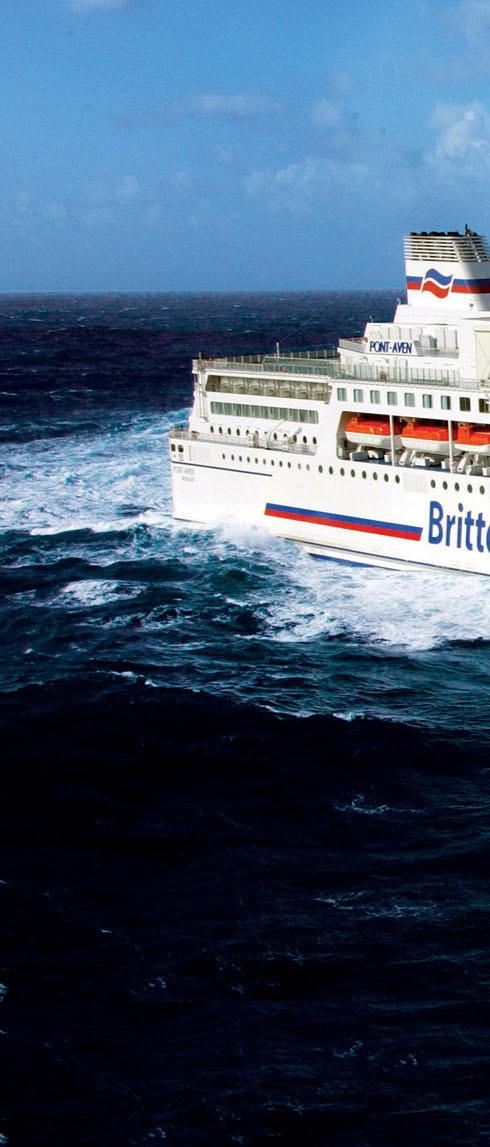
The modernisation of ferry services has revolutionised the experience of travelling across the Irish Sea, North Sea and The English Channel, especially for longer overnight crossings to the Continent. Start your holiday in style and travel on spacious ships, enjoy fine dining in à la carte restaurants, relax with a spa treatment and sleep comfortably in en suite cabins; on arrival you feel refreshed for the onward journey. There also plenty of facilities to keep children entertained during the crossing, including soft play areas, games rooms, live entertainment and cinema. The good news for green travellers is that you can travel as a foot passenger on many of the ferry services out of the UK and enjoy all the benefits of modern ferry travel – bars and restaurants, plenty of entertainment and facilities for families, comfortable overnight cabins and no bag restrictions. The ports on both sides of the crossing are well connected by public transport, so it’s easy to travel by bus or train to the ports in the UK, as well as disembark on the other side and continue the journey overland. Europe has never felt closer.



There are several ferry options for travelling between the UK and Ireland: you can choose a ‘fast’ or ‘slow’ ferry and travel as a foot passenger. Both Stena Line and Irish Ferries allow you to book both the rail and ferry legs of your journey in one go, known as a Sail & Rail ticket, at a price that is much lower than if you booked the two legs separately.
This combined train and ferry ticket can be for journeys from anywhere in Great Britain to anywhere in Northern Ireland and the Republic of Ireland via the UK ferry ports of Holyhead, Fishguard or Cairnryan. The Sail & Rail option is also available back from Ireland to the UK. There is no option to upgrade with these special Sail & Rail fares, but one of the distinct advantages of this Sail & Rail package is that the fares come at a fixed price that doesn’t increase in peak travel periods or is dependant on how far in advance you book. You can book the Sail & Rail tickets on the website of Transport for Wales, which manages Sail & Rail fares on behalf of all British train operators. There’s a 50 per cent discount for children aged 5–15, while those aged 0–4 travel free. You can also buy Sail & Rail tickets online at trainsplit.com and avantiwestcoast.co.uk


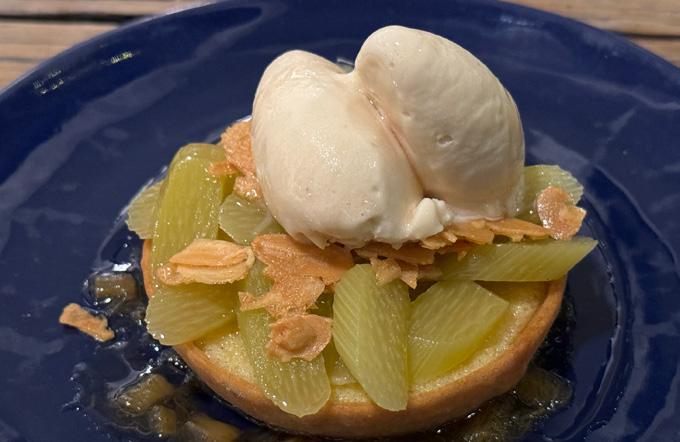

From Bordeaux to the Dordogne Valley, expect world-class cuisine with a range of specialities
Words by Richard Hammond
Discover Nouvelle-Aquitaine in our Green Traveller’s Guide to this beautiful region. Explore Bordeaux (just 2 hours by high-speed train from Paris), Biarritz and the Pays Basque, Cognac, Pau and the Pyrenees, the Dordogne Valley, Limoges, and Poitiers. Here’s our pick of four special places to eat in this foodie’s paradise:
Zéphirine, Bordeaux
Tucked away on a side street a stone’s throw from Place Gabetta, Zéphirine is a Michelinstarred intimate urban diner with an open kitchen, a small patio terrace and even a small delicatessen so guests can take away a few of the delicacies. There’s single short menu: you share starters, choose from three meat, fish or vegetarian dishes then choose from a selection of deserts. It’s run by an experienced trio of Romain Corbière, his sister Marie-Zéphirine and her husband Bertrand Arnauld. ‘Zephrine’ is their great-great-grandfather’s name, so expect age-old recipes conjured with refined expertise; it’s outstanding value. zephirine.fr
The wooden-framed glass windows of the facade might suggest a traditional, formal atmosphere at this Michelin-starred restaurant, but inside, Vivants is laid back and welcoming. The elaborately decorated dishes – the attention to detail is exceptional – are the hallmark of chef Tanguy Laviale, previously of Garopapilles who also runs the show at the popular Michelinstarred Ressources restaurant, close to Place Tourny. At Vivants, there are three menus of 3, 4, and 5 dishes – expect dishes such as scallops with persimmon and vegetarian tortelli – and choose from a comprehensive list of over 1,000 wines, thankfully a helpful sommelier is on hand to help you pair your selection with your food. restaurantvivants.com
Tucked away in a quiet corner of this popular village, just off the Place de la République, Restaurant l’Entrepote is a cosy restaurant with exposed stone walls and a outdoor terrace in a charming, timeless courtyard, serving

regional cuisine using fresh market ingredients. There are classic dishes such as goats cheese salad, carpaccio, and magret de canard, but also variations such as pork tacos, calamari, vegetarian tartelette, and pork in a morille mushroom cream sauce.. eroccitan.com
Choose between the characterful outdoor terrace or the cosy interior at this popular 4th generation run bistro (previously known as Les Frangins) in a quiet corner in the heart of Brive. The owner Paul works with many local farms and you can expect beautifully presented dishes, such as red tuna, Limousin beef rib chops, carpaccio and and exquisite rum baba – a soft cake in a delicious rum syrup, with full-course vegan options available. There are more than 200 wines to choose from drawing on Paul’s extensive experience as sommelier in a Michelin-starred restaurant.

As the days grow shorter and the summer heat gives way to crisp autumn breeze, the Innsbruck region becomes the perfect destination to unwind and explore.
Whether you’re soaking up the fiery colours of the season, watching the sun set behind the mountains, or catching a glimpse of local wildlife, autumn here feels like nature’s own invitation to slow down.
One of the region’s most spectacular natural


If you prefer something more challenging, the 35km ‘Genuss-Radweg’ food-themed cycling route rambles across the plateau, passing farm shops and local outlets selling everything from freshly baked bread and artisan cheeses to home-made meats and preserves. These culinary pit stops are also accessible by walking, so you can pair your autumn hike with a taste of the region’s finest.
Autumn evenings in the Innsbruck region are a sight to behold. Ride the Patscherkofel cable
“It’s the perfect season for British travellers who want to unwind, explore at their own pace and enjoy a more authentic side of the Alps.”
Colette Verra, Marketing Manager at Innsbruck Tourism Linajärv
displays is the “burning larches” on the Mieming Plateau. In October and November, the landscape trades its summer greens for golds and reds, set against a stunning alpine backdrop. A gentle walk here lets you wander through glowing woodlands and if you’re lucky, you might even find ripe juniper berries along the way.|
car, running until late October, and you’ll be greeted by a horizon of over 400 peaks, with the sun setting slowly behind the mountains. Up here, the city below feels a world away.
For more adventurous walkers, there’s an excellent sunset hike in the Axamer Lizum. Beginning at 2,340 metres above sea level at the Hoadl, the route climbs to the Pleisen, a
challenging ascent where you’ll be rewarded with a breathtaking panorama.
Autumn in the Sellraintal Valley comes alive with an increase in nature sightings. From late September to early October, the bellowing of deer fills the mountains as stags compete for dominance. With luck, you might also spot local chamois or marmots on a peaceful walk through the mountaineering villages of Gries, St. Sigmund and Sellrain.
For something a little gentler and familyfriendly, try llama trekking in Obsteig. These calm, curious creatures set the pace for a relaxed wander, letting you switch off and embrace the season’s slower nature. Start your slow travel experience before you even arrive.
Innsbruck sits at the heart of Tyrol and is well connected by rail, with regular services linking major cities. From the UK, take the Eurostar from London St Pancras to either Brussels or Amsterdam and then the ÖBB Nightjet sleeper train direct to Innsbruck.
t’s milking time at the Cortijo de Pavon cheese factory and all hands are on udders. With a 400-strong herd of Canary Island sheep there’s no time to waste. The Mendoza family has nailed this process. Milk hits the aluminium buckets like hail on a tin roof and before long a full lechera (urn) is being hoisted onto a trolley and wheeled at pace to the production area. “Raw milk adds properties to the cheese but the milk’s temperature must be maintained,” explains my guide, Rafa Molina whose company EtnoExperience Canarias, specialises in ethnographic hiking routes.
Hands also help to maintain the temperature of the cheese. I followed two of the farmers into a small, stone building where the unpasteurised milk is poured into an oblong vat and salted and paddled before the coagulation process is initiated with a sprinkling of rennet. The curd is sliced into ‘grains’ and the whey filtered into buckets. The cheese is then wrapped into muslin parcels, kneaded to expunge more liquid and pressed into circular moulds. The entire handson process takes around 40 minutes. It isn’t only farming skills that have straddled four generations of this family. An ancient
pastoral tradition known as transhumance binds them to the land. Towards the end of June the two female sheep farmers I’ve been observing, Belén (26) and Laura (21), will pack up a few belongings and pick up the trail of the nomadic shepherds, walking between mountain refuges for up to 12 hours a day. The lush pastures of the mountain north enrich the milk of the sheep and are ideal for fattening up the herd. Meeting female shepherds in their 20s was the first of many surprises during a recent visit to Gran Canaria. The popular winter-sun destination is well known for its beaches, sand
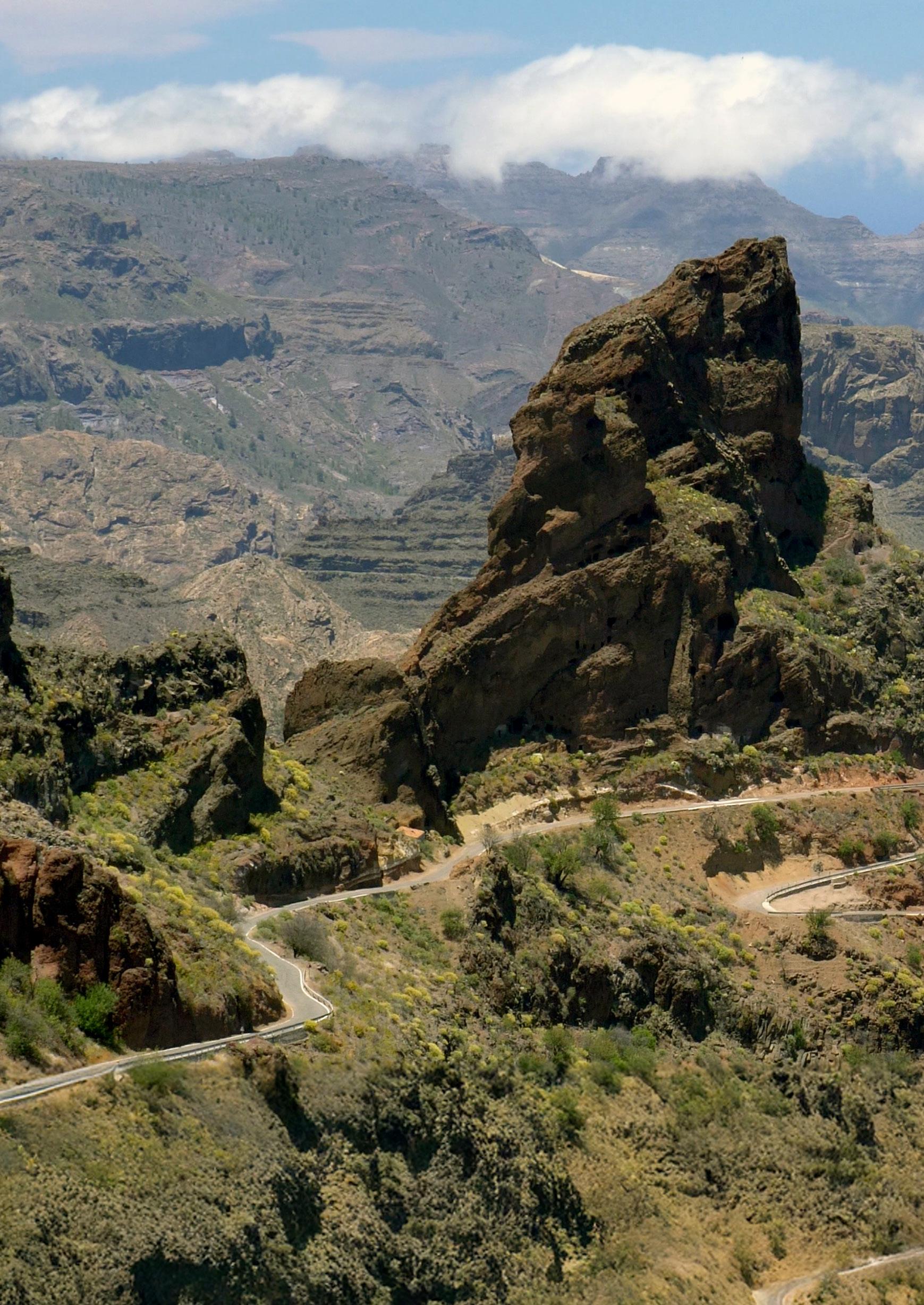

dunes and resort hotels. Point the handlebars inland, however, and you’ll find hiking trails that thread through laurel forest, world-class archaeological sites, natural parks sheltering endemic flora and birds and village restaurants where tables groan with farm-to-fork produce.
As well as supporting a sustainable, circular food system, transhumant shepherds are helping protect the land from the increasing threat of forest fires. According to the environmental conservation organisation Gran Canaria Mosaico almost half of the island’s surface area sits within a high fire-risk zone. Wineries, cheese factories and small farms are the island’s greatest allies, because ‘every cultivated field, orchard and meadow acts as a productive firebreak.’
The Wherever I ate the words ‘zero kilometres’ (Km.0) usually cropped up. Canarians are fortunate to have a climate that facilitates a field-to-table approach to dining but a deeprooted passion for the terroir is a key ingredient in the food on the plate.
As well as its artisanal goat, sheep and flower cheeses the island has potato, coffee and banana plantations and vines that march across volcanic slopes. Almonds, of which there are more than 50 varieties, warrant an annual blossom festival, held in the village of Tejeda in February. Travelling around I tasted jams made from sunripened tomatoes, figs and prickly pears, honey, prized navel oranges, papaya and pork from the indigenous black pig.
Incredibly, 43 per cent of land in Gran Canaria falls within the Gran Canaria Biosphere Reserve, an area that encompasses several villages, including Tejeda and Artenara, in the centre of the island. This year Artenara found its place on Spain’s list of Pueblos Mágicos – ‘living towns’ singled out for – among other criteria – practices that preserve the environment, heritage and culture for future generations. For a small island, it is quite an achievement.
In the town’s San Matias plaza, I pulled up a chair at Arte-Gaia Bio Tasca (the loose translation is “organic tavern”) and set about eating the land. The day’s lunch menu featured watercress soup
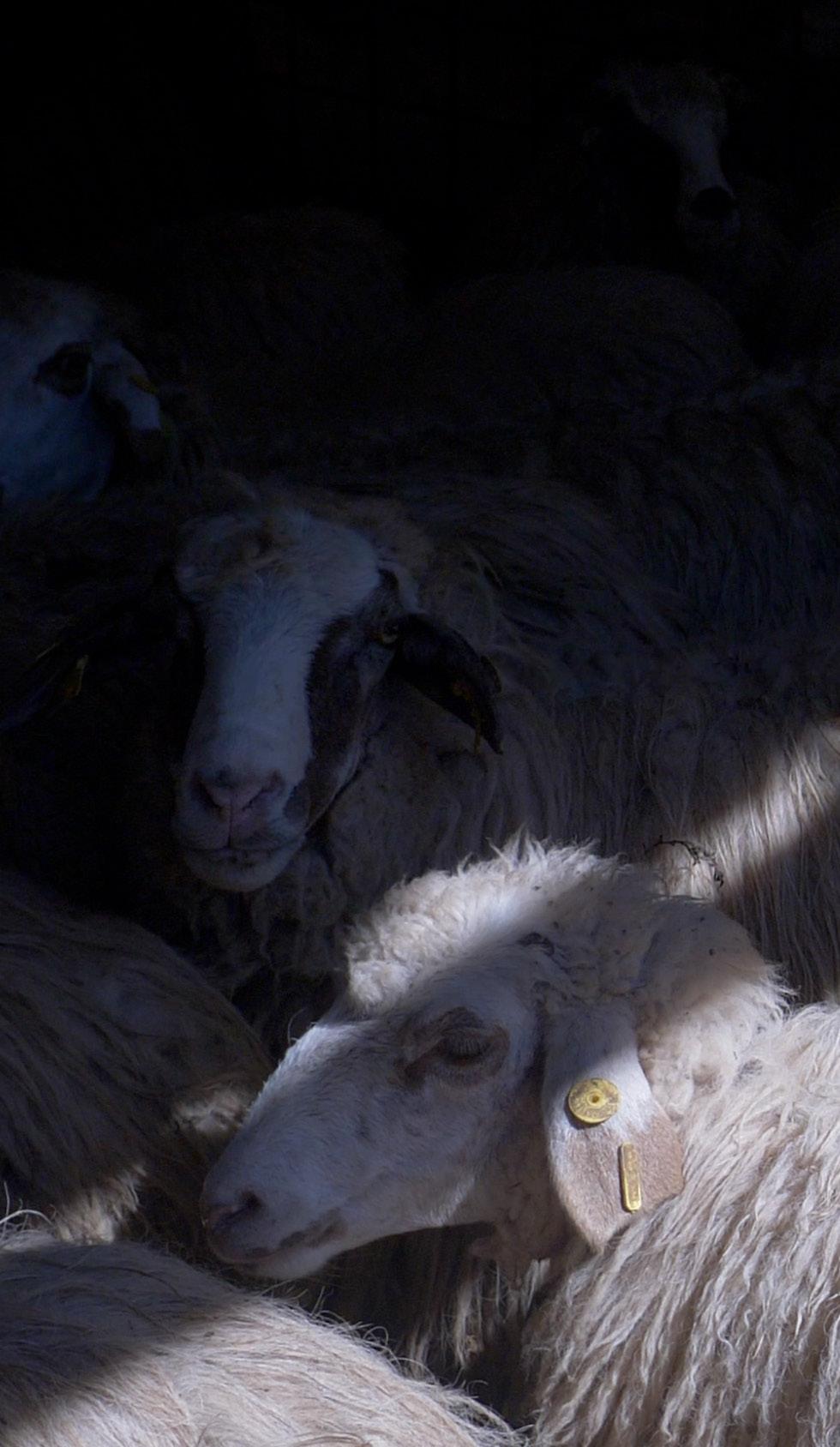

Canarians are fortunate to have a climate that facilitates a field-to-table approach to dining but a deep-rooted passion for the terroir is a key ingredient in the food on the plate
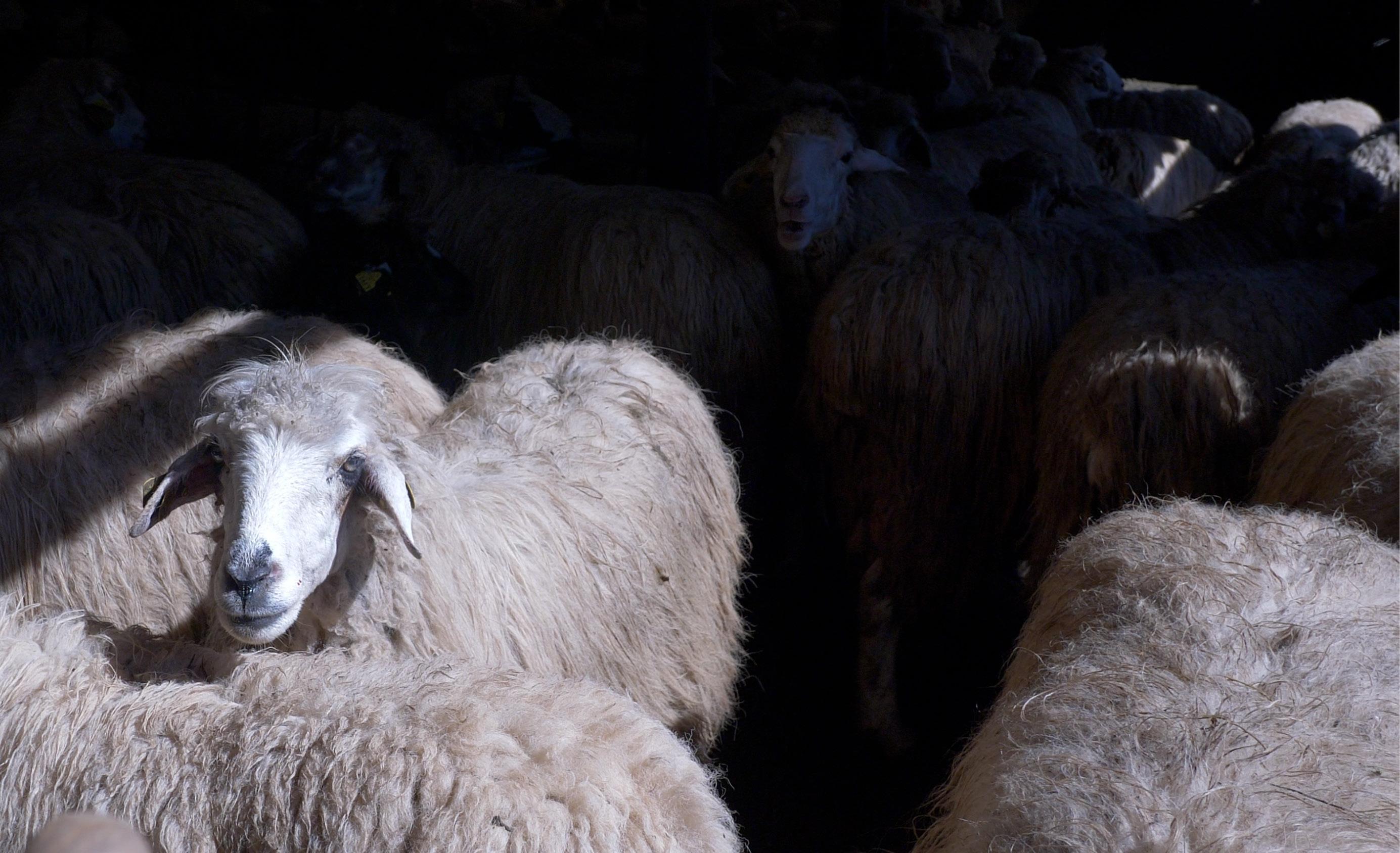
with corn, chickpea, saffron and Canarian pork rib, roasted aubergine smothered in palm syrup and cheeses from the Biosphere Reserve. The papas arrugadas – small, flavoursome potatoes cooked and served in their wrinkly jackets on a puddle of spicy mojo sauce, deserved special attention. “The potatoes are from the ravine and the mojo is an old lady’s recipe,” said owner Juana Teresa.
The “ravine” she mentioned is in the fertile Tejeda crater. A few minutes from the restaurant is a viewpoint offering yawning views across this monolith-strewn bowl.
In pretty Tejeda, an edge-of-the-caldera village full of traditional, white-washed houses, marzipan lovers go to die. Here, I discovered bienmesabe, an almond-based sauce to be dribbled over ice cream (or eaten straight from the spoon) and, at the other extreme, saquitos de morcilla te van (which translates as ‘little pockets of blood sausage’).
“You will love them,” said the waiter at Cueva de la Tea, as I popped a filo pastry parcel of black pudding mixed with pine nuts into my mouth. And he was right.


The last two decades has seen a huge resurgence in traditional wine-making, with unique varietals and scores of bodegas across the island.

It isn’t just potatoes and almond trees that thrive in the Biosphere Reserve. The last two decades has seen a huge resurgence in traditional wine-making – with unique varietals and scores of bodegas across the island. The absence of phylloxera allows vines to be cultivated using ungrafted rootstocks, allowing varieties to harvest the soil’s minerals.
It isn’t just potatoes and almond trees that thrive in the Biosphere Reserve. The last two decades has seen a huge resurgence in traditional wine-making – with unique varietals and scores of bodegas across the island. The absence of phylloxera allows vines to be cultivated using ungrafted rootstocks, allowing varieties to harvest the soil’s minerals.
As our car wound through the volcanic valley I wondered how much higher we could go before running out of road. Eventually we came to a halt at Bodegas Bentayga. Set on the slopes of Caldera de Tejeda, the winery was founded by Don Juan Rodriguez, who in the early 1990s converted an old dairy farm into a winemaking facility.

Most of the current vines were planted in 1994, at altitudes ranging from 1,050 to 1,318 meters, making this the highest-altitude winery in the Canaries. Juan Armas’s legacy continues under the direction of his daughter, Sandra.
Part of the winery is excavated from stone and a cool cave that extends from the winetasting room houses red wines maturing in American, Hungarian and French oak barrels. During the 90-minute tasting I sampled a clean, flinty and rounded white, Agala Altitud 1318 and a red, Altitud 1295, that was somehow light but packed with plummy depth.
Outside, among the butterflies and vines, I drank in the land, both literally and metaphorically. Directly in front of the bodega is Gran Canaria’s emblematic Roque Nublo, and beyond, Roque Bentayga. It wasn’t the first time I’d seen and felt their presence, but this front-row view of the monoliths is unmatched. Back at Cortijo de Pavon, Belen invited Rafa and I to taste the cheese. Not the white, fresh (younger than 20 days) rounds lined up on rows of shelves like single-layer wedding cakes, but the semi-aged cheeses on sale in the farm’s small shop. Before we

leave the production room, I ask the girls about shepherding. What about a social life, partners and Tik Tok?
Belen says she is completely committed to the business she is taking over from her parents. She loves the “quiet” of the production process and the cathartic, hands-on nature of the work.
Laura gave up a job in the town of Galda to work at Cortijo de Pavon. She wanted to pursue a different way of life. She loves her work, she says, and feels part of the family.
As we sat in the sunshine, eating our cheese, Rafa hit the nail on the head. “It’s not just about making cheese,” he said. “It’s about nature, landscape, culture and prevention.
“Tourism is well balanced here. Our identity is visible.”
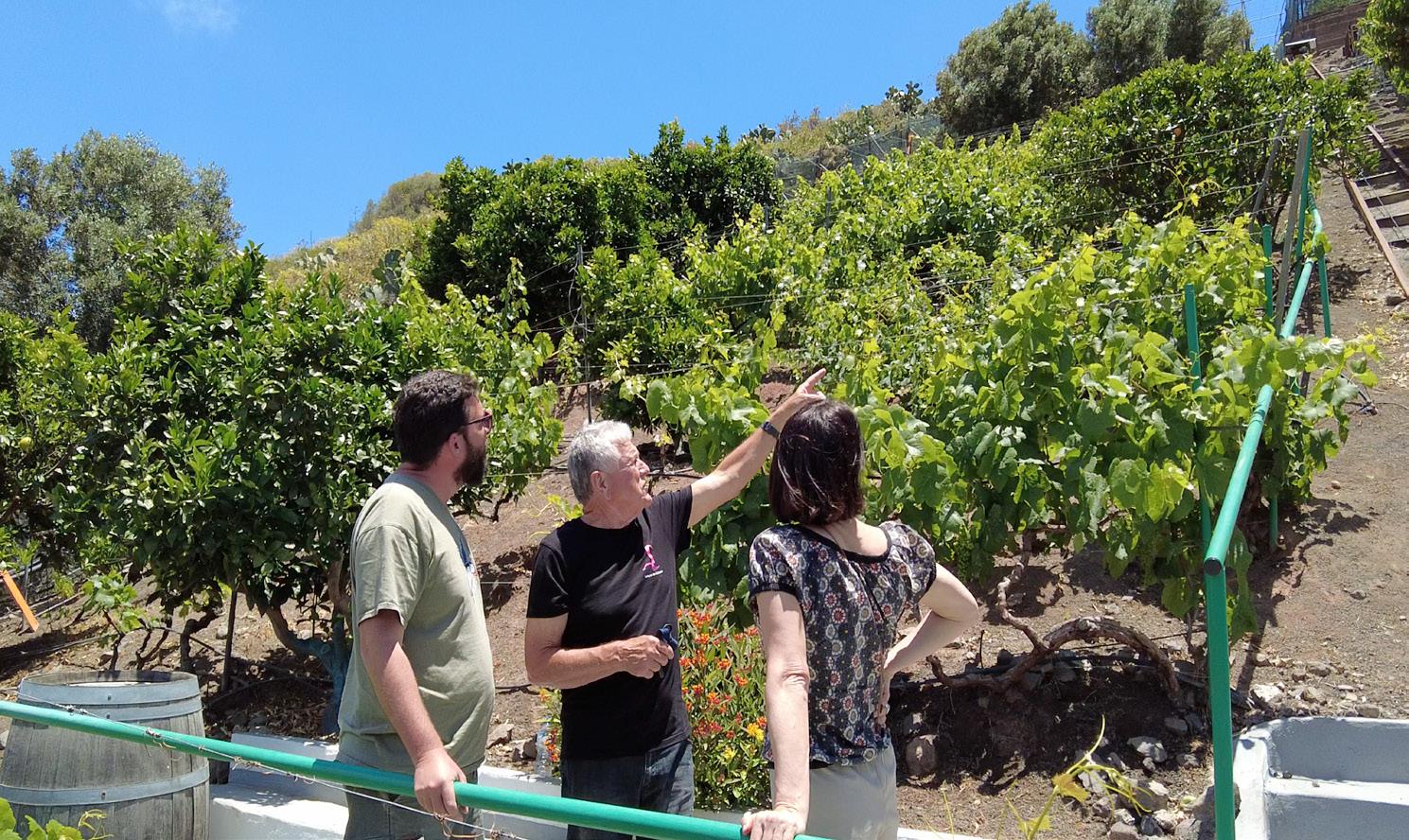




There are two ferry routes from mainland Spain to the Canary Islands: from Huelva (near Seville) operated by Baleria; and from Cadiz, operated by Armas Trasmediterránea.
For how to travel to these ports from the UK without flying, see Green Traveller’s Guide to how to travel overland to Spain, including ferries from the south of England as well as travelling by train via Paris and Barcelona.
The ferries from Huelva run to the Port of Santa Cruz de Tenerife (which takes about 40 hours) and stop at the Port of La Luz in Las Palmas de Gran Canaria en route.
The ferries from Cadiz run to most of the main islands, including Fuerteventura, Gran Canaria, La Palma, Lanzarote and Tenerife, taking 28–35 hours.


Richard Hammond and his family walk a section of the 60-mile circular trail along ancient paths, sleeping in churches along the way

As the morning light filtered through the stain glass window behind the altar, I glanced over to see if my two boys were still asleep in their sleeping bags, on a camp-bed, in a church. They were, and it was no surprise they were still in the land of dreams; it had been as peaceful a night as I could remember. Tucked up among hassocks and hymn books, our sacred abode was as silent as the graves outside.
St Clydawg Church was one of two we stayed overnight in while walking a section of the Golden Valley Pilgrim Trail in Herefordshire. The full week-long 60mile circular pilgrimage begins and ends at Hereford Cathedral (a mile from the city’s railway station), where you can stay overnight in the cloisters. There are ten other churches along the route that offer a “night sanctuary” in the villages of Eaton Bishop, Madley, Tyberton, Dorstone, Peterchurch, Michaelchurch Escley, Craswall, Clodock, Ewyas Harold and Kingstone (booking essential: www.abbeydoredeanery.org/gvpw).

We only had time for a stretch of the trail, about half-way along, following beneath the Black Mountain ridge between the age-old villages of Craswall, Clodock and Ewyas Harold, walking in the footsteps of monks, traders, drovers, priests and pilgrims, who would have walked this historic valley. We began on a Friday afternoon at Michelchurch Escley, 13 miles west of
The uniqueness of the place made us feel like we were doing something a bit special


Hereford, from where it was a short walk to Crasswell; a 4-mile stroll to get us in the swing of things. My boys (aged 10 and 12) are used to going on walks near our home on the Mendips in Somerset, but it always takes them a little while to get going, so my wife and I thought it would be a good idea to start off with an easy walk with a guaranteed hot meal at the end of it. That came curtesy of Anita, owner of Chapel House Farm campsite – a brilliant campsite just 15-minutes from Hay-on-Wye. Campers can pitch in 15 acres of wildflower fields bordered by ancient

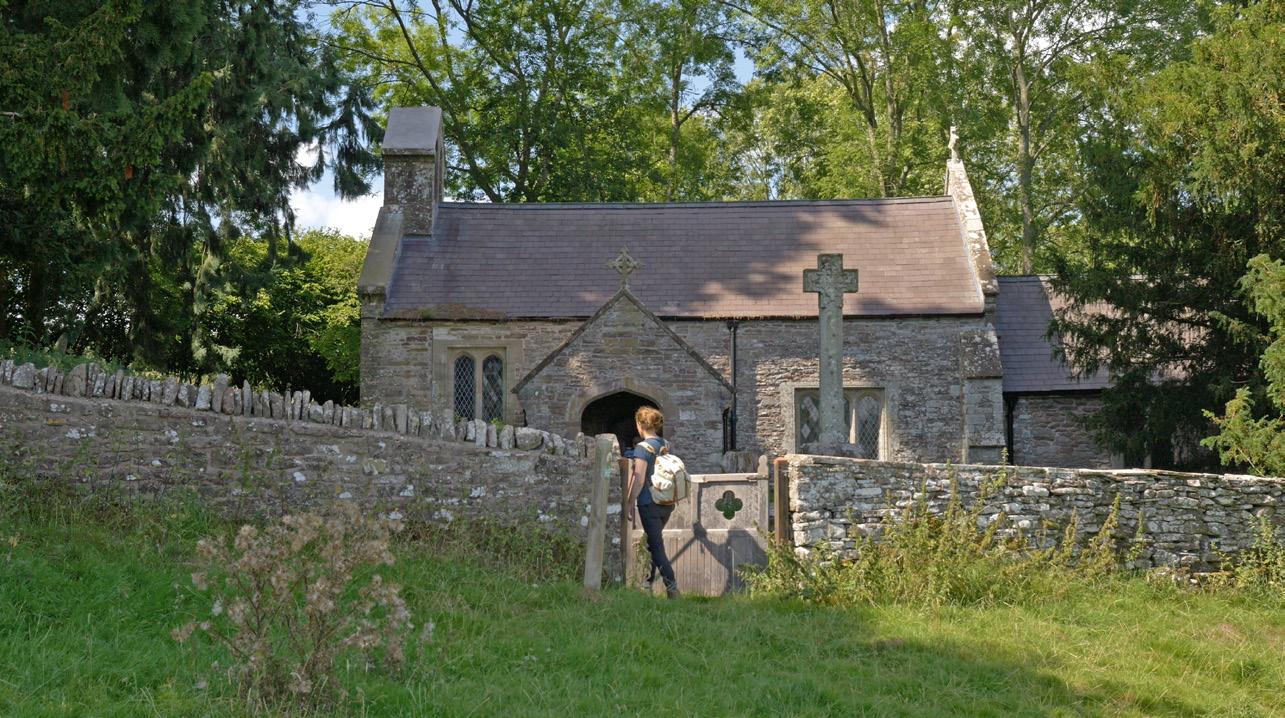

woodland, or for those who like their creature comforts, there’s a fully furnished bell tent as well as a more rustic wooden pod. It’s a great campsite for children who can make dens, run in the woods and play games in the long grass. Anita is well used to catering for Golden Valley pilgrims and she served up a wonderful meal for us in the fading light of the day, including beef from her own farm with salad also grown on site.
Chapel House Farm is just along the road from St Mary’s Church, Craswall, a small Norman church in a field surrounded by a small glade. A short walk is the Bulls Head, a traditional drover’s inn and farmhouse, now a gastropub with a traditional ‘Hole in The Wall’ bar and a flagstone floor. Come here for a fireside pint or to relax in the beer garden, and for fine dining – there’s wholesome, flavoursome meats from the owners’ farm, homemade charcuterie and a traditional roast on Sundays.
Staying over in St Mary’s Church was our first taste of church camping and although there was some unease at first – the silence amplifies the eeriness – once we’d made a cup of tea, set up our camp beds and had a good look around, the uniqueness of the place made us feel like we were doing something a bit special. Just like the famous Santiago de Compostella pilgrim way in France and Spain, you can collect stamps at the churches along the route that go in a beautifully designed passport that my boys loved collecting.
From Craswall, it was 7.5 miles to the village of Clodock, up and over farmland, across a patchwork of fields, moors and meadows, passing apple orchards, ancient churches and


Celtic stones. At Longtown there was a ruined Norman castle and a well-equipped village shop where we stocked up on provisions. We passed the famous ‘Cat’s Back’ ridge (the hill looks like a hunched, sitting cat), and further on, the higher ridge above Longtown there’s the famous ‘Offa’s Dyke’ long distance footpath. You get a taste of both gentle wooded river valleys and mountain landscapes all along the trail. That evening we ate at the The Crown in Longtown and slept at our second church, the 12th Century St Clydawg Church in Clodock. With over 800 gravestones, it’s dedicated to St Clydawg, King of Ewias, who was martyred about 500AD – the building stands on the site of his tomb, in a picturesque setting beside the river Monnow and overlooked by the Black Mountains. A stone’s throw from the church is the characterful
Cornewall Arms where you order through a serving hatch and can choose to play darts, table skittles and quoits.
After another restful night in the church, we walked the final stretch of this section to the village of Ewyas Harold, stopping for a drink and a bite to eat at the Carpenters Arms. As with all the places we stopped at on this walk, it was steeped in history (it’s 300 years old and has been run by the same family for generations). We arrived in the yellow glow of the afternoon light, similar to what we’d experienced throughout the walk – from the crisp morning light to the stunning golden hour in the early evenings. Apparently the name Golden Valley comes from a mistaken identity – the Normans thought it was named after mis-hearing the Welsh word for water which sounded like ‘gold’, but the name fits it perfectly. A truly golden walk. www.visitherefordshire.co.uk



Jill Sayles explains how to make the most of improved ferry services between the Greece mainland and the beautiful islands of Corfu, Paxos and Lefkada
Thanks to recent boost in new ferry services and enhanced inter island links, it’s never been better to go island-hopping across the Ionian Islands of Corfu, Paxos and Lefkada. Several ferry companies including Kerkyra Lines, Joy Cruises, and Lefkada Palace have begun seasonal connections linking Corfu, Paxos, Lefkada, Meganisi, Ithaca, Kefalonia, and Zakynthos, on a looping schedule from mid-April to mid-October. Lefkada Palace was built in 2021 and carries up to 200 foot passengers. The routes from Corfu are every Monday, Wednesday and Friday and in the
opposite direction every Tuesday, Thursday and Saturday.
Services are weather-dependent, so with flexibility in mind, alternative sailings can be organised and accommodation needs and activities may require rescheduling. Kerkyra Lines has connections to Lefkada by road via Igoumeista port, continuing the journey overland from there if required as the island is connected to the mainland by a road bridge. There are also hydrofoil services that cut the journeys by around half, so there are several options to keep things moving.

While onboard, enjoy the views either by sitting in the fresh air outside on the upper deck or inside below deck and take in the vistas as you pass the islands, mainland Greece or Albania, depending on the route. The inter-island ferries are sturdy, clean and offer plenty of seating with a café and facilities onboard.
Crossing times from the mainland and between the islands are approximately:
Igoumenitsa to Corfu: 1 hour 30 minutes
Corfu to Paxos: 55 minutes
Paxos to Antipaxos: 15 minutes
Paxos to Lefkada: 3 hours

Corfu Old Town offers a blend of Venetian, British and French influences and a walking tour is the ideal way to take it all in.
A good place to start is at the Old Fortress, a UNESCO-listed Venetian stronghold surrounded by beautiful sea views. The twin peaks of the fortress “Coryphe” in Greek gave Corfu its Western name. It now houses the Public Library of Corfu, the Hellenic Music Research Lab a church, a museum, and hosts various art and cultural events. The grounds also include a cafe-bar, a sailing club, and a restaurant.
From the fortress gates, it’s a short stroll to the Durrell Gardens, named after two of the famed British writers Gerald and Lawrence Durrell who lived on the island in the 1930s, and their bust statues can be rubbed for good luck. Continue to the People’s Garden between the Palace of St Michael and St George and Mandrakina Church. Designed in the Greek Revival style, the palace was originally the residence of the British Lord High Commissioner of the Ionian Islands and is now home to the Corfu Museum of Asian Art. Head over to Spianada Square and the cricket pitch for year-round matches.
Next, take a stroll down the Liston Promenade. Built under French rule from 1807 -1814 and inspired by Rue de Rivoli in Paris, it was once a gathering place for aristocrats and remains a popular spot today for people watching, while enjoying a drink or something to eat.
Wander to St. Spyridon Church dating back to 1570, the town’s tallest building and home to Corfu’s patron saint. The Spyridon Festival is a huge local celebration in August.

Further into the old town at St. Jacob’s Square is the baroque town hall and the nearby Catholic cathedral.
The small pedestrian streets are filled with independent shops, local craft sellers, cafes, bars and restaurants. The fruit and vegetable market sell kumquats that are grown widely across the island; the fruit’s liqueur and other Corfiot treats like traditional fig pie can be sampled at the Lazarus Distillery. Local ginger beer called Tsitsibira was introduced by the British during their occupation in the 19th century. Other locally produced treats such as Loukoumi and nougat reflect its multicultural heritage.
A Corfiot gastronomic gem is Flisvos restaurant located by the Ionian Sea at

Kanoni near the beautiful Vlacherna Monastery and overlooking Pontikonisi, also known as Mouse Island.
Flisvos, meaning “the sound of waves”, was founded by brothers Dimitri and Spyros Catechis. Situated among stunning views and with the thrill of being able to watch planes taking off and landing at Corfu airport, the restaurant delivers modern Greek cuisine with a local twist. Seafood takes centre stage, from marinated raw fish and grilled catch-of-theday to fish Bianco, a Corfiot classic cooked in garlic-lemon broth with potatoes. Appetizers include taramosalata, mussels with ouzo, and smoked eggplant with marinated anchovies.
Venetian-influenced Corfiot pasta dishes are also featured, such as shrimp paccheri and lobster ravioli. Salads use fresh local ingredients, and desserts celebrate Greek
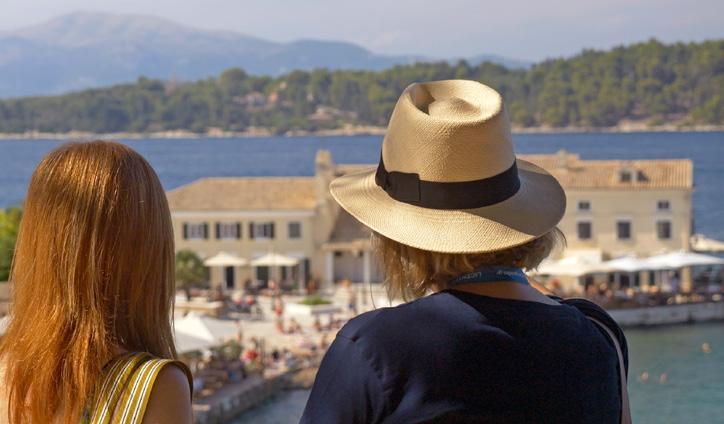


cuisine with yoghurt millefeuille, rose petal spoon sweets, and crispy filo.
Dimitri says: “Visitors want to taste what grows here and are interested in learning about the history and culture of Corfu.”
He also runs Corfu Wine, offering tastings that showcase Greek wines, including retsinas and vintages from local vineyards, making Flisvos not just a meal, but a full sensory experience of Corfu.
Sunvil Corfu representative, Julia Manetas adds: “Clients are looking for something different now, they are not just coming here for the sun and beaches, so even better if they can incorporate experiences into their meal times.”
Paxos is a small island at just 12km long and 2km wide, where the areas of Gaios, Lakka and Loggos offer quintessential Greek charm.
The capital, Gaios, with its Venetian architecture, a folk museum and waterside cafes gets its name from its landmark church, Agios Gaius. The harbour has two islets - Agios Nikolaos and Panagia. Nearby stands the statue of Greek war hero Yiorgos Anemoyiannis, a Paxos native recognised for his bravery during the Greek War of Independence.
To the north, Lakka lies in a sheltered bay with tavernas and Venetian merchant
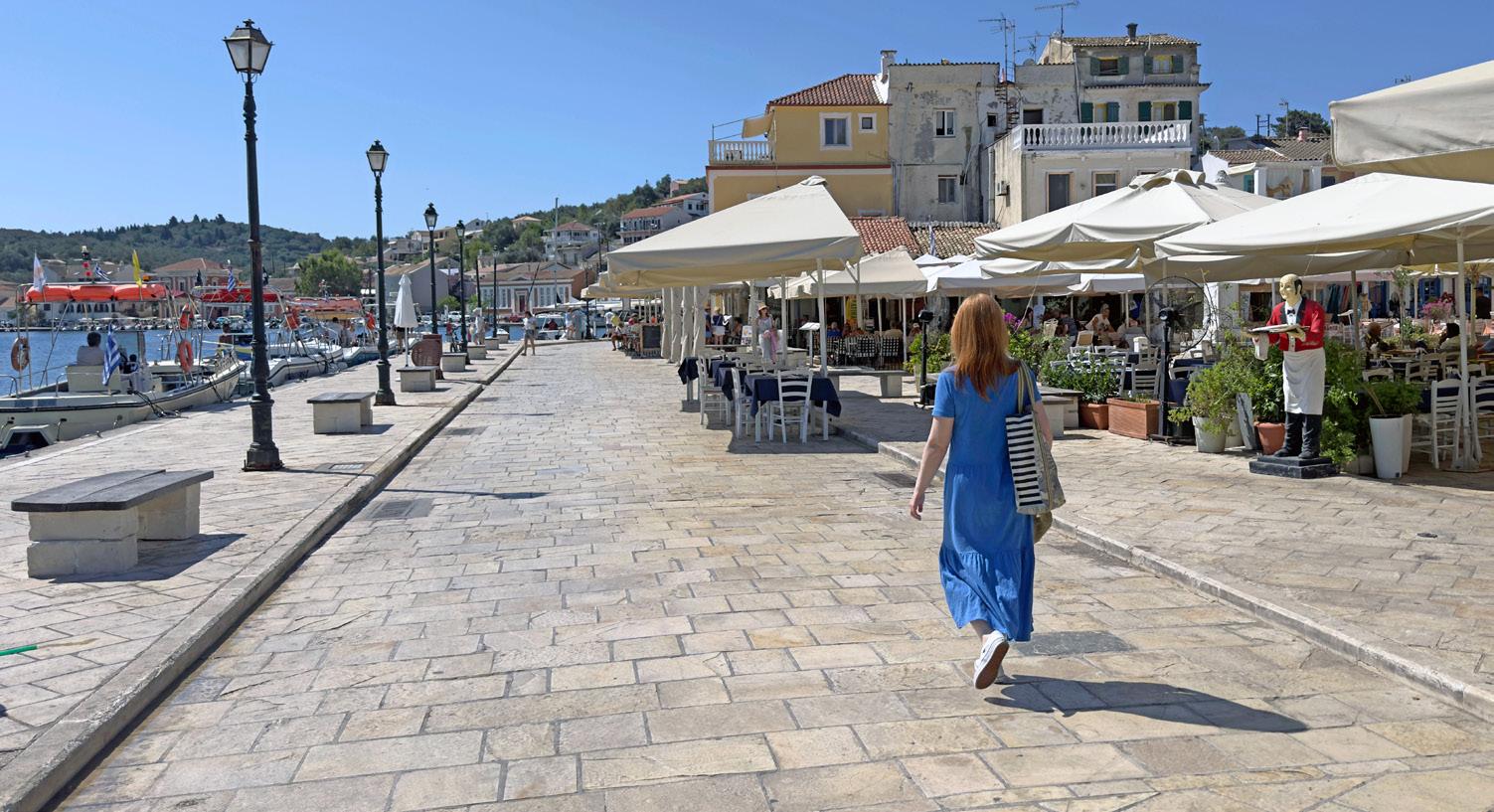
houses. The lighthouse is a historic landmark and the village has local markets, shops and squares.
Loggos is popular for its intimate and picturesque horseshoe-shaped waterfront and its historic olive oil and soap factory that operated from the late 19th century until 1980s, carrying a legacy of cultural heritage for the island.
Paxos has more than 30 east coast coves and beaches, many of which are only accessible by boat. Monodendri and Levrechio are near Loggos, and Mongonissi, an increasingly popular area near Gaios is now joined to Paxos by a causeway, offering a great spot for swimming, with a beachfront taverna.
Antipaxos, a mile south, has stunning sandy beaches, Vrika and Voutoumi, and is reached via boat trips from Gaios.
Sunvil representative Paxos Andrea Florio believes there is something for everyone: “The island itself it makes you feel at home, you can get the perfect balance here with the climate, the people and the food.”
For spectacular sunset views, head west to Erimitis Bar & Restaurant, and from the clifftop location enjoy beautiful Ionian Sea views. Back down at sea level Vasilis Restaurant, just a couple of metres from the port front of Loggos, has been offering Greek traditional dishes from the region since 1957.
Near the main square in Gaios is Carnayo Restaurant. Owner and head chef Spyros Tranakas has been at the helm for the past 18 years, where following his training in Germany, he returned to his ancestral home. His personal mission was to elevate Greek and Paxiot flavours through refined traditional and modern fusion dishes, for visitors and locals. In his words: “We want customers to feel at home. We’re putting something authentic on the plate.”
At Carnayo, the focus is on fresh, local ingredients, many from Tranakas’ own garden, and locally caught fish. The menu lists Greek cuisine with authentic Italian pizza and sushi, thanks to a dedicated sushi chef who has been onboard for the past three years. Starters range from classic Greek salads and meze fish plates to tempura sushi and grilled courgettes with raisins, walnuts, and an aubergine mousse. Signature dishes include lobster pasta enriched with lobster eggs, saffron, and basil oil, and Neroladia Paxiot Dakos, a rustic salad with local bread, feta, and olive oil. Plus there are desserts like olive oil vanilla ice parfait and marmalade, or pana cotta made with Greek yoghurt. The restaurant can also cater for villas and boat trips.

Lefkada is also known as called Lefkas and sometimes referred to as “the island that isn’t,” as it is connected to mainland Greece by a causeway and a floating bridge. The 303sqkm island takes its name from the white “Lefko” cliffs on its southern coast.
Lefkada Town is the capital and main hub, while Nidri, located 34km from the ferry port is the island’s main resort.
Lefkada offers many watersport activities and the beaches on the west coast are considered the most beautiful. However, lesser known are the agricultural offerings and rugged natural beauty in the hills near Nidri.
An important part of the island’s agriculture is the cultivation of lentils that
have been produced there for hundreds of years and are widely used in the local cuisine. Sunvil Lefkada representative Julie Norton can offer a new tour of Vasso Kort and her family’s lentil farm, with the process demonstrated by Vasso, near the mountain village, Eglouvi.
The lentil harvest in August is celebrated with a popular festival and the three small authentic tavernas in Eglouvi’s main square offer dishes made from the pulses. Ta Lyrata café and taverna serves a delicious lentil soup and lentil burgers, made by sibling owners Xara and Spyros, who also sell local products they have made including olive oil, jams, liqueurs and soap.
Other heritage activities offered include a visit to the embroidery village of Karya,

known for its delicate Alarya stitching, a local olive oil museum, honey farm and vineyards. The Lefka white rocks create ideal conditions for growing grapes at the vineyards, especially the island’s Verdea and Verzamo varieties.
If you want to venture out to sea, long-time British Lefkada resident and marine expert Steve Clarke-Lens offers a private guided tour offering everything from rare wildlife, swim and snorkelling spots, ancient history and quiet island charm, including a visit to the Panthera Cave, an archaeological site where evidence of Neanderthal habitation has been found, dating back over 45,000 years.
The Lefkada Micro Farm near Nidri offers a hands-on culinary experience, where guests harvest and cook a meal rooted in Greek tradition, sustainability, and slow food philosophy. Revived five years ago by owner Andreas Dimitrakopoulos’s after 30 years of ownership as an olive grove by his late grandfather, the farm has more than 60 olive trees and an organic bounty of vegetables, fruit and wild herbs. Dimitrakopoulos takes visitors on a guided walk to harvest seasonal produce and learn about the heritage and health benefits of the farm’s olive oil.
In the outdoor kitchen overlooking the


groves and produce, guests prepare the ingredients to cook and share a traditional vegetarian meal including Greek salad, tzatziki, filo pies, and Briam - which is a traditional dish of slowroasted seasonal vegetables. The experience lasts half a day and is an opportunity to connect with nature, Greek culture, and farm-to-table vegetarian flavours.

Sunvil has a 7-night island-hopping holiday in the Ionian Islands for £1,716 per person, including flight from the UK to Corfu, return flight back to the UK from Preveza, and all land and ferry transfers. Call 020 8758 4758. More info: www.sunvil.co.uk/itineraries/ greece/corfu/itinerary/island-hopping-in-theionian---corfu-paxos-and-lefkas

Community-based conservation in

Josephine Price visits a range of community tourism initiatives that are revitalising and future-proofing the island’s offering

“The green detoxifies, the purple is full of antioxidants and the gold is high in zinc”.
I’m getting a health and nutrition lesson as I stand on the beach with Mervin Mathurin, the 48-year old sea moss farmer, who quit his office job in the hotel sector three years ago after 15 years in the business to return home to this bay and his heritage, taking stock of his crop. Sea moss, also known as Irish moss or by its scientific name Chondrus crispus, boasts 92 of the 102 minerals that the human body needs earning its recent reputation globally as a superfood. But it is no recent trend here.
“[[Sea moss farming]] started a long time ago here with my dad and just a cluster of farmers. Nothing too much”. But business is booming in this little bay on the east of the island now – it’s the island’s biggest export – and they’re inviting you in for a taste. It’s a prime example of a thriving ecosystem entwining the local and tourism ventures. The farmers – between

BAMBOO
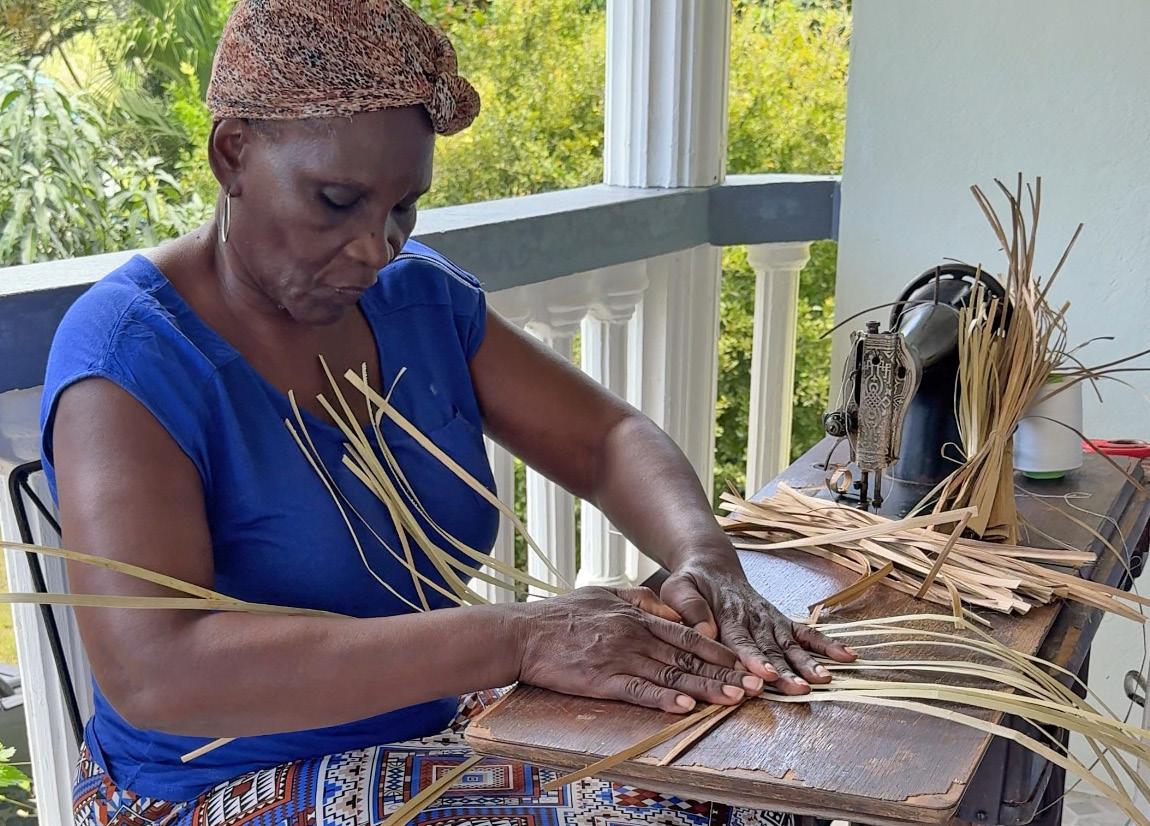
150 and 170 in this bay, but around 500 island-wide – do their thing and the world has cottoned on to what they’ve got. As demand grows, there’s a younger generation of farmers, male and female, getting involved which is good for both business and the community. Across the bay, a small setup called Kayak on the Bay (a family-run restaurant and kayak hire outlet) provides the opportunity for people
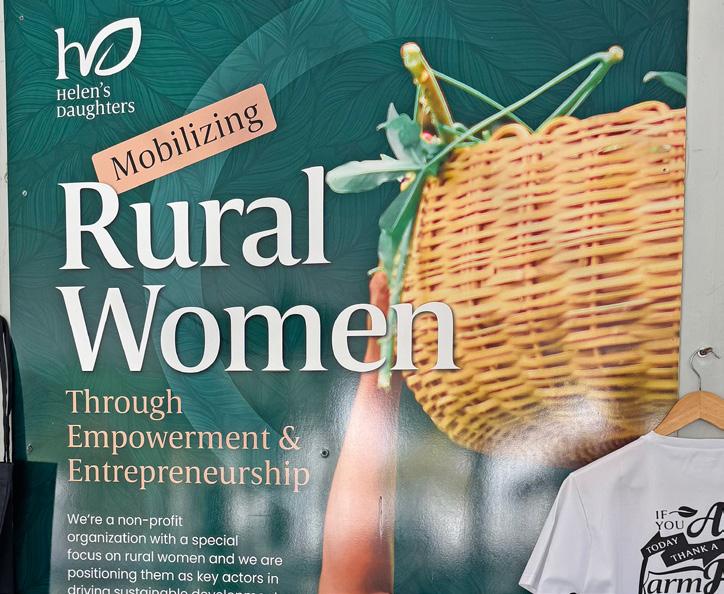

to go and visit the sea moss farmers and learn about the practice and their product, bringing interest and income to this part of the island where the tourism product and infrastructure is still light touch and local.
Later, I’m standing waist-deep in the Atlantic, among the submerged plants with Mervin. “This is one of the most beautiful bays on the island for sea moss,” he tells me. It’s picture perfect to me. And it’s accessible for local farmers too. On a low tide you can access as far as the island by foot which means it attracts the farmers who can’t or don’t swim too. On top of its accessibility credentials, it’s a low-impact, short-harvest affair. You plant, you leave, you harvest, you dry, you sell. It takes six weeks from planting to product. This is small-scale farming with a light environmental footprint but a big local money impact and a global reputation.
It’s even impacting activity across the community. Meveline Daage, the 35-year-old
founder of the kayaking spot tells me: “Initially when I started Kayak on the Bay [[eight years ago]] it was to bring a sustainable, ecological watersporting activity to the bay. But it has shifted because all of the attention has focused on the sea moss farmers. All our guests come to see them. What is this sea moss? Everyone is intrigued about what it is.”
And now the purpose of the tours has shifted and expanded to incorporate it. Local fishermen provide the daily catch, lunch is cooked by Meveline’s family (she urged her parents to move back home from Texas, USA to pitch in with the family business) at her waterside restaurant before heading out to meet the sea moss farmers, learn more about the intriguing product and visit nearby Praslin Island. It’s a symbiotic relationship that engages and feeds the community.
This is an example of an impactful setup that could be modelled across the island. As one of the most tourism-dependent economies in the



Anse Chastanet resort hotel ticks the beachfront box as well as offering indulgent hillside accommodation and immersive experiences for guests. But its work goes beyond the resort. Projects include the Soufriere Foundation (a non-government organisation for the benefit of the neighbouring community), supporting coral restoration with nurseries and education as well as wider projects to help conservation, sustainable livelihoods on the island and marine health. ansechastanet.com
East Winds (right) is one of Saint Lucia’s longest-running boutique resorts and it’s easy to understand why the guests keep coming back to this all-inclusive haven tucked away from the popular Rodney Bay harbour. Stay here for laidback luxury set in lush verdant gardens next to a serene sandy bay. Garden tours showcase the island’s medicinal and much-loved flora, the all-new kitchen garden, and the island’s first ‘living banana museum’. eastwinds.com

world, the Caribbean is a delicate proposition. Faced with rising temperatures and tides impacting coastlines, fishing industries and seaweed invasions, for example, there’s an urgency to do things with a positive impact to protect and preserve the string of islands. With more visitors than ever before and tourism development on an upward trajectory, I’m here in the eastern Caribbean island nation
of St Lucia to see just how the West Indies is looking after their patch. Protecting the future is a project, but it’s also an invitation. Their island-wide warm welcomes and gracious hosting should almost come with a disclaimer: come in and get involved. And thanks to community tourism initiatives, it’s easy to. There are no alarming calls to arms here, but a gentle invitation to interact and get involved.
The community tourism initiatives I experience across the island are propelled by local characters who realise what a good offering they’ve got and want to share it with the world.
That’s certainly the case with Stephan at the St Lucia Bamboo Rafting project. This 22-year-old energetic soul is the supervisor here and my guide for the experience. He grew up on a nearby tributary of the Roseau River, which was once a lifeline for the producers upstream: the island’s biggest banana plantations would send their crops down on bamboo rafts to be picked up for export from the beach.
It was also where Stephan played, messing about on the river with friends. And today, locals and tourists are taken down on similar bamboo rafts built by local boys. It only takes them a couple of hours to build a raft and the bamboo is in such surplus that it remains a low-impact activity. This initiative doesn’t change the landscape, coastline or the river but it does introduce visitors to one of the natural lifelines of the island and provides the local community with another way to earn money from the visitors.


These tours have been running for three years now and it’s a gentle way to catch a glimpse of life on the water. We make our way downstream past fruiting almond trees, loud moorhens and rocky cliffs pockmarked with honey bee hives to Roseau Beach. It may be just round the bay from the hotels and restaurants of the prestigious marina at Marigot Bay but here there’s nothing more than a shack and piles of sand from government-approved sand-mining ventures. Kids dive into the water from surplus rafts, probably just like Stephan did in his day. Maybe these kids will be the ones launching the next new venture in years to come.
Longevity is key to such projects, the act of giving ideas time to bed down and have an impact. Next up, I’m exploring Emerald Farm with Elijah Jules, the 43-year-old executive sous chef at the Anse Chastanet and Jade Mountain resorts. The farm has been running here for 18 years and he’s been with the resorts for 16 years. He’s having a good time, especially with his creations, and it’s infectious.
He feeds me dish after dish, adorned with herbs and ingredients from the garden, bursting with flavour and colour. A tomato gazpacho that I’m still thinking about. Fat buttery curried prawns with coconut-milk-braised green banana. Seared, herbcrusted tuna atop a shaved cucumber and grapefruit salad. This experience is available to hotel guests, connecting them with the land as well as the hotel’s community outreach and organic farming initiatives.
Top row: Meveline Colmet Daage, Kayak on the Bay; Mervin Matherlin, Seamoss Farmer; Elijah Jules, Executive Sous Chef, Anse Chastanet & Jade Mountain Centre: Stephan Charlie, Bamboo rafting
Bottom row: Arthur Anthony, Lushan Country Life; Velda George, Craftswoman, Choiseul; Mishach Alcee, Tour Guide, Tet Paul Nature Trail www.ctasaintlucia.org


ARE PROPELLED BY LOCAL CHARACTERS WHO REALISE WHAT A GOOD OFFERING THEY’VE GOT AND WANT TO SHARE IT WITH THE WORLD.
The organic farm located in the Soufrière Hills is all about the farm-to-table experience as guests find out more about local ingredients and the provenance of the dishes onsite but it goes beyond that, enabling the resort to have a conversation and a relationship with local farmers, too. “We have the space to plant [and grow] everything we want to but we plant what the locals don’t plant,” Eli tells me.
“And if we have to plant what they don’t plant, then don’t plant a lot.” Slightly further south, in the inland valley of the Pitons, Project Chocolat is another St Lucian gem with a far-reaching impact. The estate behind the UK powerhouse, Hotel Chocolat, has been pioneering sustainable and organic farming changes on the island since they launched operations here in 1994. With this vast 140-acre site, they could plant
all their own crops and function independently but instead they work in collaboration with the local farmers.
“The core purpose of being here was to revitalise cocoa as an industry on the island. They started with a handful of farmers in this area and they set up a programme called Island Growers where they would grow and heavily subsidise cocoa seedlings, give them to farmers and we would guarantee to buy it at a premium price,” the CEO, Emma Peacock explains.
It’s this style of gentle hand-holding from the island’s custodians that sets a tone and leads me through St Lucia, educating and empowering me – as they hope to with more and more visitors. There are plans to launch new tours and experiences later in 2025 through the tourism agency’s sister organisation, the Community Tourism Agency.
And as Meveline at Kayak on the Bay says community involvement is key. “My hope for Praslin Bay is to see a lot more sustainable tourism practices being picked up,” she comments on the nascent industry in her corner of the island. And from the looks of it, it looks positive. The Caribbean – and St Lucia –may have its fair share of resorts but the future looks set to get more sustainable by putting the community first.




Green Traveller is our go-to film production company. They instinctively understand how to handle delicate and complex issues, how to tell our story in a way that will motivate our audiences, and how to get the best from the people and places we work with.
Ben Lynam, Head of Communications, The
Travel
Foundation

Shining a light on sustainability, life stories and adventure through writing, photography and film, since 2006
Green Traveller Media specialises in film production — storytelling, aerial (we are licensed by the CAA to operate drones in the UK and by the EASA in Europe), interviews and interactive videos — and produce online visitor guides and social promotions.
We also provide content and distribution services for campaigns, working with established PR Agencies to promote specific projects to targeted consumer and trade media.
